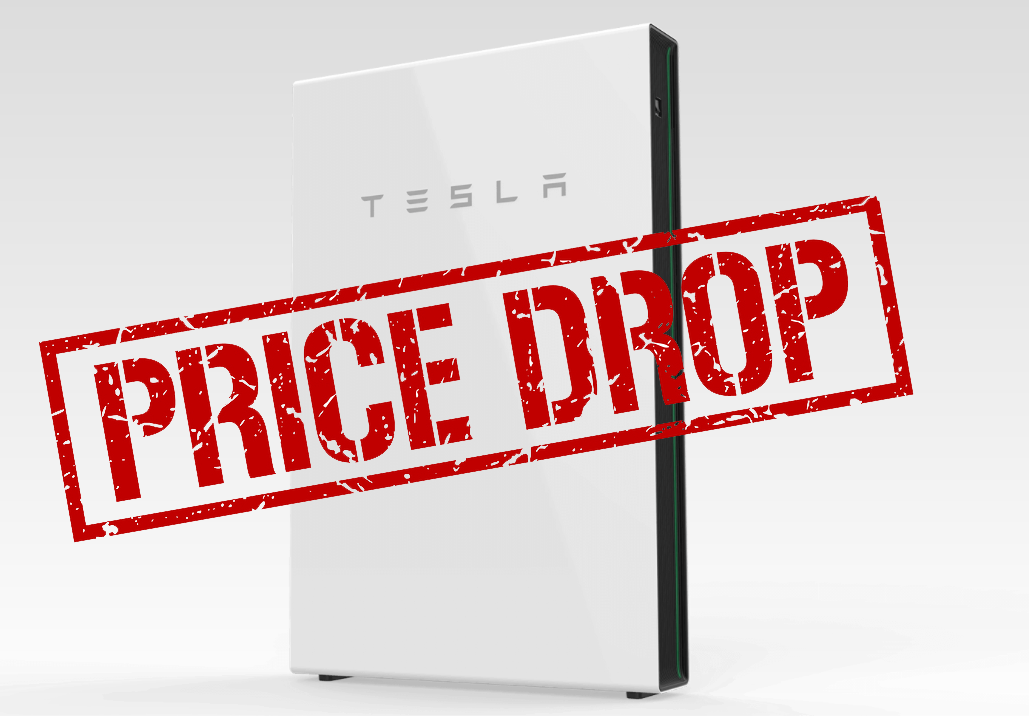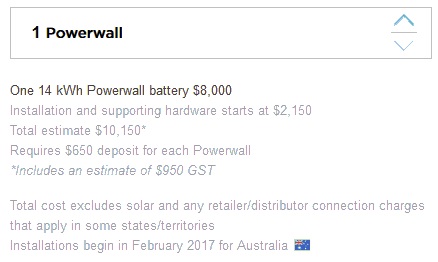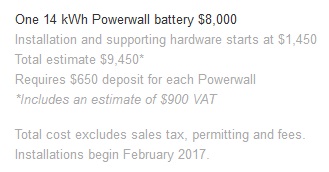
The Tesla Powerwall 2 is now $800 cheaper in Australia.
Tesla appears to be unsure about how much to charge Australians for the Powerwall 2.
Or maybe they are sure, but confused about how the Australian dollarydoo works.
Perhaps they’ve been confusing it with the New Zealand doubloon or the Fijian guilder?
I know I often do.

“Crikey! 900 dollarydoos to the New Zealand doubloon and 6 centaroos to the Fijian guilder!”
My opinion may not be worth much, but my two centaroos is they simply launched before they had all the details worked out.
Some people think the price of a product is an important detail that should be worked out in advance. And they are correct – provided you want to do things the boring way.
There are two ways to run a company:
- The boring way, where you waste time making sure people who work for you know important details in advance.
- The exciting way, where you make announcements that catch people in your own company unaware and force them to scramble to catch up and try to fill in the details in a mad rush.
But whatever the reason, so far Tesla has given three different prices for the Powerwall 2 in Australia. Or at least, three I know about. There could have been a few I missed. But the good news is the current one is cheaper than the last one.
Tesla now says the Powerwall 2 will cost $8,000 dollars including GST. This is a 9.09% price drop1.
And “Installation and supporting hardware starts at $2,150”.
So their estimate of the installed cost of a system starts at $10,150. This is all shown in the screen capture I took today:

A screenshot taken from Tesla’s Australian website on the 6th of Decemberydoo, 2016.
They say the price includes an estimate of $950 GST, but if its total cost is $10,150 then surely GST should come to $923? Maybe we’ll get a fourth price out of Tesla in the future fixing this discrepancy, or maybe they’ll just go, “Meh, close enough.”
The Evolution Of A Price
Anyone who’s played Pokemon Go knows what evolution is. And just as fluffy animals in apps must sometimes be tortured to grow stronger, sometimes prices and specs must be tortured for a company to grow in strength and customers to grow in confusion.

The Tesla 3 electric car will come with a 56 kilowatt-hour Pikachu.
The First Price
On the very first day Tesla announced the existence of the Powerwall 2, the Australian Tesla website put up the following:
While I didn’t understand why it needed one, I thought it was nice that it came with a $900 vat. It would be especially useful in South Australia because we could use it for wine making. But then it was explained to me that VAT was actually Value Added Tax, a double sized GST in the UK, a country formally known as EU.
It appears that Tesla couldn’t tell the difference between Australia and the UK. But that’s understandable. After all, if you add a few kangaroos to Britain and sprinkle a few spotted dicks around Australia the two places basically become indistinguishable.
The Second Price
But regardless of what Tesla called the GST, their estimate of the total installed cost of $9,450 was impressive. Unfortunately it didn’t last. It only took Tesla two days to contact us and say they had made a mistake and the $9,450 estimate actually didn’t include GST or VAT. This meant their estimated installed price was really $10,395. While not as good as we were first told, this was still much better than the competition.
But I have to admit, I wasn’t surprised the price got bumped up. Not after what happened with the original Powerwall. Tesla has never given me the impression they are a “set in stone” kind of a company. They’d have to work at it for me to regard them as a “penciled in on a post-it note” company.
The Third Price
Tesla now has a third price up on their Australian site. It’s been the same for at least a couple of days now, so who knows? It could even be their final price! But I wouldn’t bet on it.

Elon Musk: “This isn’t even my final form!”
The third price drops the cost of the Powerwall 2 by a big honking $800 from the previous one by including GST in its $8,000 price.
However, the starting price for “installation and supporting hardware” has increased by 23% from $1,755 to $2,150
Overall the total installed cost is 2.4% cheaper than it was. While not a huge improvement, it’s a change in a direction I like.
Australians Aren’t Getting Screwed!
The third price means, at current exchange rates, we will be paying about the same for a Powerwall 2 as people in the United States.
Actually, at today’s exchange rate2 we’d be paying 1% less. It makes a pleasant change from companies that shaft us on price when they come to Australia.
Not only are we getting a 1% discount but we’re also getting free shipping!
Of course, it’s not possible to know what will happen to exchange rates between now and when the first Powerwall 2s get installed here. Perhaps Elon Musk expects the demand for gold to build giant Presidential statues will push up the Australian dollar?

Donald Trump: “This is my final form!”
Arrival Date
At least Tesla are consistent about the release date. They are standing by their statement that they will start installing the Powerwall 2 in February. Personally, I’ve put down 20 cents on March as the month of the first installation in the local Powerwall 2 sweepstakes. And that’s only because I’m an optimist. To me they seem a little too disorganized to be ready by February. For example, just above the new price they describe the Powerwall 2 as a 14 kilowatt-hour battery, but in their technical specifications they state it can provide 13.5 kilowatt-hours with a 100% depth of discharge. They can’t both be right.
Cost Per Warranted Kilowatt-Hour
At $8,000 for an uninstalled Powerwall 2 its warranted cost per kilowatt-hour is only 21 cents, which is well ahead of anyone else. The increase in the installation estimate means the installed warranted cost per kilowatt-hour doesn’t improve by much, but it’s still quite impressive at 27 cents. Of course, just as with the original Powerwall, we’ll have to wait until they actually start being installed to see how good they really are.



 RSS - Posts
RSS - Posts



Having read this would you care to ponder what Enphase might do with its 1.2 kW Battery Storage Pricing in Australia?
https://www.greentechmedia.com/articles/read/Enphases-New-25M-Loan-Bets-It-All-on-Next-Gen-Microinverters-and-Energy-S
Enphase is squirming whilst sitting on a foul balance sheet. If Enphase doesn’t think quick they will cook their goose and be bankrupt within a year. They claimed they’d get microinverters nearly at the price of conventional inverters in 2 years and it’s been 1 year so far.
A 1.2kW battery is so small it would be pointless. One tenth of the size of decent competitors products, and that’s still half the size of what most households should have to really be worthwhile.
And I’d imagine the unit cost of it would be un-competitive too. Market flop?
Folks. Please stop saying 1.2kW when you mean 1.2kWh. They are different units. It’s like the difference between km and km/h – don’t those units seem different to you?
It doesn’t matter for products where it is easy to tell that the writer has made a mistake, but 1.2kW AND 1.2kWh are BOTH plausible for house batteries.
Agreed! http://www.solarquotes.com.au/blog/kw-and-kwh-what-is-the-difference/
I’d be happy to order the unit only via the website and simply arrange for my local trusted electrician to do the install.
As soon as we have to order the things through some retailer, that’s when we start getting pillaged and ripped off. The Australian retailing industry is why everything costs so much more than it should.
That’s why it is imperative that customers can order directly from the manufacturer.
its our high wagers and the cost of housing in the capitals that keep driving the prices up. At some point we must take a hit and someone will loose a lot of investment money.
That’s not a bad thing for the country, our standard of living has to drop because as many countries are now finding out costs have got out of control and I will bet in the next 10 years unemployment will rise dramatically and the government will have no choice but to increase taxes in order to maintain the basic necessities that we demand as a civilized society.
We have moral responsibility to care for the elderly,provide education and to provide health care.Battery prices come last
Considering it took Fronius nearly 6 months to finally update their inverters to talk to PW1. I assume I can look at hopefully getting my Fronius Hybrid and PW2 DC to be compatible just before the launch for PW3
What is likely to happen to the Feed In Tariff when Electricity retailers realise people would rather switch off their solar panels then let them steal our green energy at 6 cents and sell it back to us for 27 cents?
How are they going to meet their green energy targets and carbon credits they used to steal from us?
Batteries is the way to go but the price needs to come down a little more to make them economically viable, then it will be time to disconnect from the grid completely. How will these coal burners meet their carbon credits and licenses to pollute then?
not sure ,but the electricity supply companies will never pay more than their KW costs from a coal fired plant. I am sure they are crunching figures as we speak to decide if its cheaper to pay for a feed in or cheaper to build their own plants.
And the owner suppliers do not pay for getting our solar power through the poles and wires. They should pay their percentage.
The AUD used be called (and is fast approaching again) the Pacific Peso
The Kiwis can keep their Doublydoons
PS What is this ‘supporting hardware’ to which Elon refers … or is it perhaps still more vapor than … hard?
Considering the PW2 has the inverter built into it, the extras should just be the hard-wiring to your meterbox and appropriate circuit breakers. Should not be much in materials, mostly labour for the sparky doing the job.
Was thinking the same thing exactly, if Tesla are truely serious about mass adoption they should just release a set of instructions for all sparkies to follow and then let us hop on line buy the P2 and phone a local to install it.
Then at under 9 grand all up things start looking interesting!
It’s like everything in life.They will charge what people are prepared to pay.
When it doesn’t sell they will drop the price for instance a 10% price drop might stimulate an increase of 11% in sales or maybe not.
The price will continue to drop until they find the sweet spot between profit and costs, that’s how businesses run .
I have an idea that in the future the government may start providing subsidies for the installation of solar batteries.
If a Chinese manufacturer enters the market and halves the cost or a new technology of storage batteries emerge you may well find that a Tesla battery will be nothing but an expensive toy.
My prediction is that a new technology will emerge and it will find its roots in Smartphone battery development providing,a lighter solution, more storage capacity and longer life .
I find it impossible to see how it can cost so much for the soft costs.
Making 6 terminations and the software settings for the inbuilt inverter can not take hours to justify the $2150.
It should take a maximum of 3/4 of an hour @ $160 plus travel of say $150 the cost would be $310 for a retrofit.
If doing a new installation the cost should be less as the travel is part of the whole cost structure.
Is Tesla only allowing a restricted few to do the install and taking an extra $1800 gross in back payment for the battery?
This just does not add up period.
Hi John,
It’s a little more than that now that I know what went in.
There is a big grey box called the Tesla energy gateway which monitors the power flows between the solar system, mains grid, house circuit and the Tesla Powerwall. The energy gateway is a separate box to the Tesla Powerwall2 itself.
It houses the 3G connection so that Tesla can collect all the performance metrics and to do OTA firmware updates remotely and does not need to rely on the consumer’s WiFi/ADSL/NBN connection. But it also has a WiFi AP built in. The installer uses this to set the unit it. But you can directly connect to it to get live statistics and output that information to a website like PVOutput. Tesla pays for the 3G for the 10 year warranty life (so that’s a 10 year cost to run the 3G service) and most likely factored in the price. The consumer does need to worry to pay for ongoing service fees.
It also includes the full house backup option so that requires a rewire of the 16 sq.mm mains cable to the switchboard.
It took 2 guys 4 hours to do the work, so about 8 man hours. It was not a simple task.
So, considering all the above, the supporting hardware is pretty much justified in its costs plus the 8 man hours work involved.
I placed an order back in January for a Powerwall 2. I was then scheduled for an install next month (September). Yesterday, got an email/phone call advising that due to technical difficulties with the gateway device and the Powerwall 2. production had stopped until the issue was fixed so that customers would not end up with a bad experience.
I was then told that it would now take up to another 12 weeks before it could be installed (meaning almost 12 months since deposit).
I wonder if anybody else has had the same experience with the delay of the Powerwall 2 in Australia recently. Just wondering if it’s worth waiting for it?
Oh don’t worry. You will get yours just in time for the pw3 launch
Finally got the Powerwall installed on Dec 11 (2017). So, it’s been in production for 12 days and performing as expected. So, in the last 12 days, only 11kWh were imported from the grid to date (so less than 1kWh/day from the grid)! I suspect that this is because it takes a few seconds for the Powerwall to detect power flows and grid import is briefly occurring while the Powerwall ramps up its production to meet instant demand if there is not enough solar production. The Powerwall works best on steady state loads. Loads that fluctuate too quickly within seconds do not help.
The Powerwall has not fallen down to 0% to date yet. So, that tells me my solar production and house usage has been matched by the Powerwall’s operation. Currently the Powerwall is sitting at 92% charge and it’s not yet noon. I have two air cons running, so that’s a big load that’s running now.
But all in all, a worthwhile wait now. I nearly considered going with Sonnen but the specs for it were less than Powerwall’s and more expensive. Sonnen still has the 10 year warranty but expected 70% battery state would eventually mean it will hold less capacity (for the 10kWh Sonnen battery vs Powerwall’s 14kWh). Sonnen only has a 2.5kW vs Telsa’s 5kW inverter. Sonnen’s Flat package has a hidden gotcha in its contract which I queried how they could offer an allowance for grid consumption. The deal was that they expected your solar system to produce so much in a year. If it didn’t, then your allowance is pro-rated to match and you would be charged for anything above the allowance (full or pro-rated) at a cheaper grid price. So, you had to be sure that your solar system would reliably produce the numbers they expect.
What was most annoying that Dominoes got 10 Powerwalls installed just the week after I had my September install delayed. I thought Powerwalls were for residential customers and that Powerpacks were for commercial customers. What’s even more annoying was that Dominoes did not have a solar system. They were purely using the 10 Powerwalls to charge at off peak and then discharge during peak hours. Tesla should stipulate that customers with solar should be accommodated first and that Powerwalls are for residential use, not commercial. Powerpacks should be for commercial customers given their size.
The firmware has already been updated to the latest version within 1 week of operation. Firmware updates only take place when the system is in standby mode so as not to affect operation.
Anyway, the long wait is over….. another nail in the coal system!
As for PW3, I predict it could be a while before it comes out. PW2 is pretty spec’d up generously as it is now, so the PW3 would have to be seriously spec’d up for the same price. I did look at PW1 and thought nah, underspec’d and overpriced. Sure enough, PW2 came out way better. Otherwise, the PW3 may have extra capacity but will be priced in. Prices for batteries may, maybe, come down but sourcing lithium is ramping up by mining companies and that could put upward pressure on global prices (supply vs demand). (Like oil). Batteries in its basic essence hasn’t really changed that much – energy storage using chemistry, sure there’s new chemistry but it’s still not cheap. It’s just that lithium has advantages over others – density(low weight to size), ability to deep discharge/recharge for price factor and size. I’ve looked at Redflow – using bromide, sure it’s a better tech but its bulky huge size/price is not going to down well in a household/domestic situation and better suited to commercial applications rather than domestic markets. Enphase Batteries are overpriced for their offerings.
Hi Graham, sounds great. May I ask how much for unit and installation? Cheers.
Hi Steve,
It cost $11688 for supply and install (about 4 hours work with 2 guys). But that also included the full house backup option. The installer proved it on the day by switching off the main switch to the grid. Solar PV was still operating under full sun (otherwise it would have gone into anti-islanding mode and shut down). Solar panels continued to provide power to the house and charge the Powerwall simultaneously. The Powerwall app showed that Grid icon was disconnected but Solar/Powerwall/House Icons were lit up. So, that’s a great feature to have in blackouts especially if it occurs during the day.
At the rate I’m using it, the PW2 should pay for itself in about 7 years. The existing solar PV has already paid for it itself. But would be sooner if electricity prices continue to rise.
It’s been just over 3 weeks now since the PW2 was installed. So far, 16kWh has been imported from the grid (10kWh of which I put the PW2 into backup mode to see what it does by charging from the grid on TOU Off peak. It draws a constant 1.7kW. This was because the following day was forecast with dark skies with low solar output. I was able to avoid paying peak rates (45c/kWh) by precharging the PW2 overnight at off peak rates (15c/kWh).
I am waiting for the TOU option to be enabled in the next PW2 firmware update. As this will be handy for winter with low solar gen.
Regards,
Graham
Hi Graham, great story and nicely said! Lots of very valuable details.
Much appreciated. Could you please share your installer’s details?
Many thanks!
As Paul’s reply, sounds like you have it covered , could you let me know who the installer is , I have a 5.5 kwh solar system and was thinking a battery would be good
Hi Colin and Paul (earlier post Feb17).
Natural Solar was the supplier (they subcontracted out due to high workloads).
I’ve had the PW2 now for nearly 4 months now…. My recent summer bill was $56. That included self-using 1160kWh (solar/battery) and my total grid use was 166kWh (I topped up the battery up overnight in prep for a few cloudy days) but most of the grid use was for the first two weeks of the summer bill as I had not had the PW2 installed at that stage of the billing cycle. I still exported 516kWh to the grid. So, not a bad bill considering, bulk being the daily supply charge.
The PW2 does not completely eliminate grid usage as some believe. The reason being is that fluctuating loads results in the Powerwall’s delayed reaction time to adjust its power output to match. Steady state loads are better (like resistive loads). Motors and variable loads (like LED TVs) are harder to predict in a few seconds, so the Powerwall can’t react fast enough to instantly match load conditions. That would require expensive electronics to sample the powerflow rate faster. My 50″ LED TV ranges from 20W to 70W in usage – and is directly related to high bright scenes to darker scenes. Things like this will cause some grid power to be drawn while the PW reacts. But if I can minimise my grid power draw to 10% of total power used, then I would be happy. I would challenge anybody if they can get complete 0W grid power draw with any battery system. The only exception are those not connected to the grid. So, to avoid disappointment, do expect some grid power draw in your periodic billing. From my experience, it is impossible to get 0W grid draw.
However, I could just flick the main switch off to prevent grid draw altogether and flick it back on when excess solar PV needs to be exported or when I need grid power (on low solar power days). But this is a nuisance process to follow. There’s more to life than running out to the switchboard just to avoid 10% grid power.
My current Autumn billing cycle usage (24 days so far out of 90):-
274kWh from Solar/battery to house.
19kWh from grid to house.
153kWh exported to grid.
So, that’s about 6.5% grid power being used and 93.5% from Solar/Battery.
The FiT from export will pay for the import quite easily.
I’m not factoring in daily supply charge. This is a fixed cost regardless how much is being used/exported and something to live with. The only way to eliminate it is high export FiT which means a big solar system. Not worth the cost.
Hope this helps…
Graham